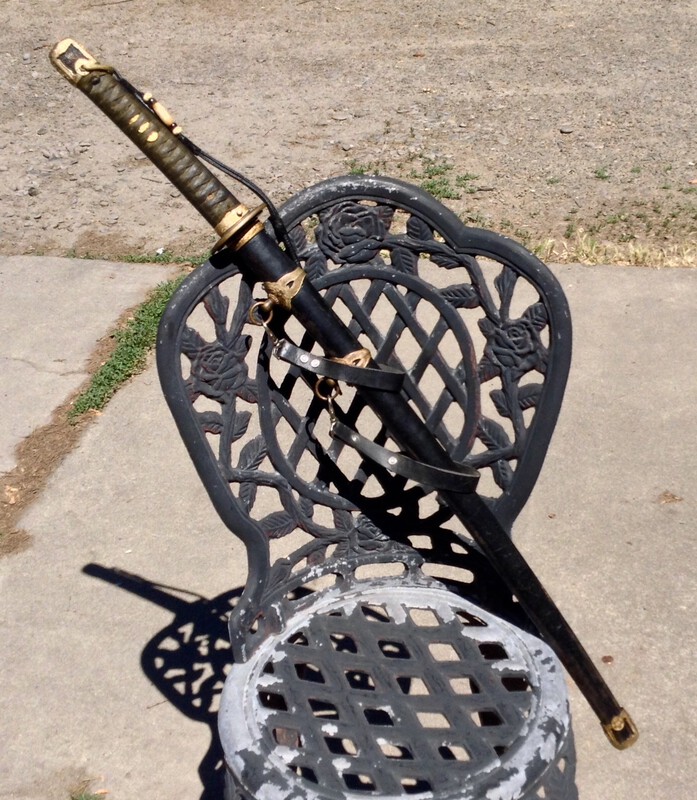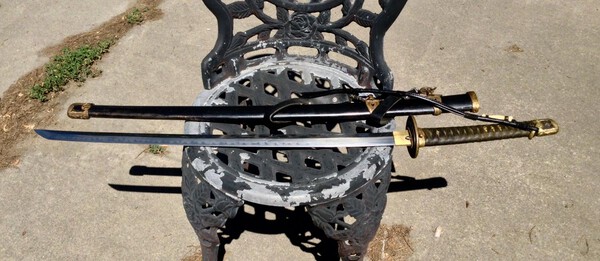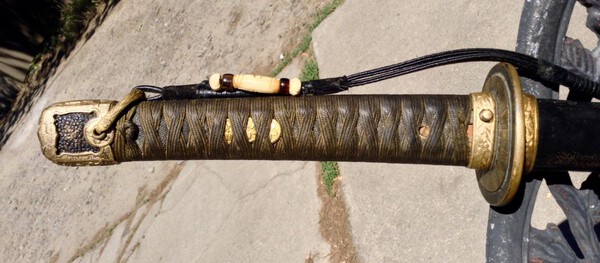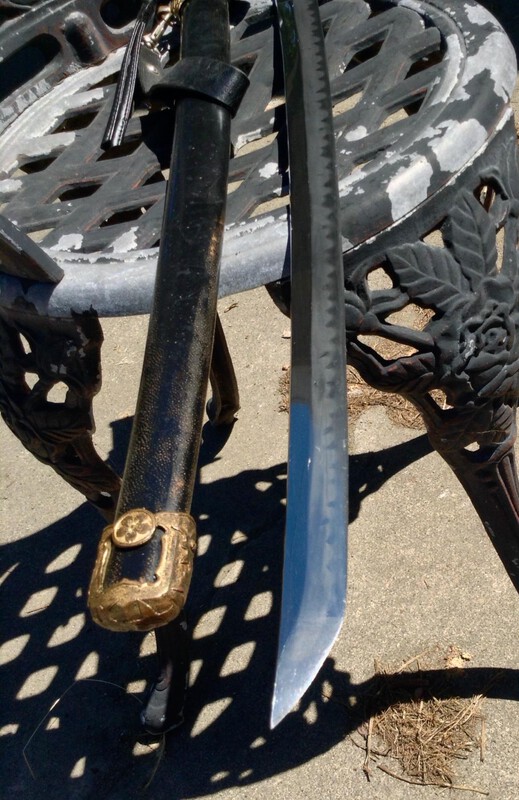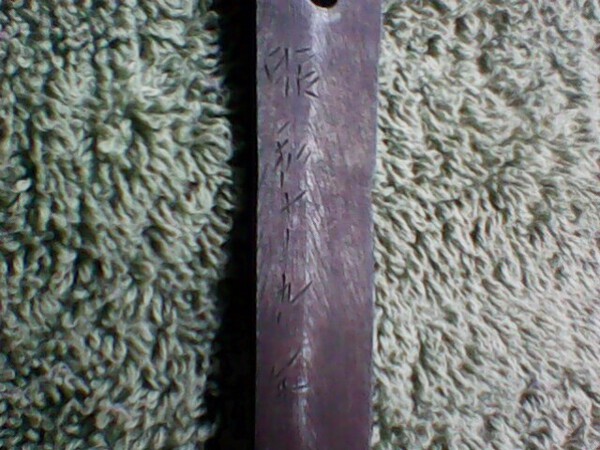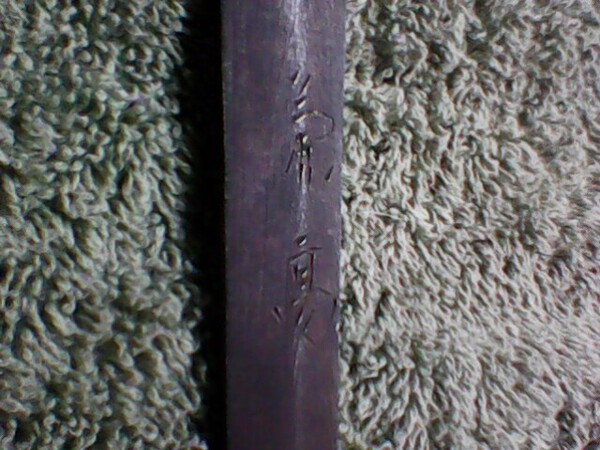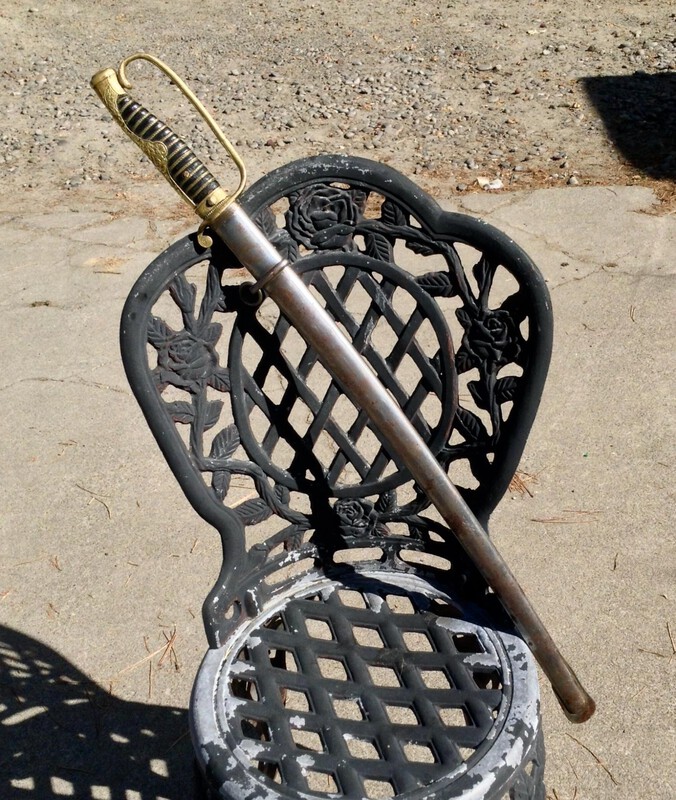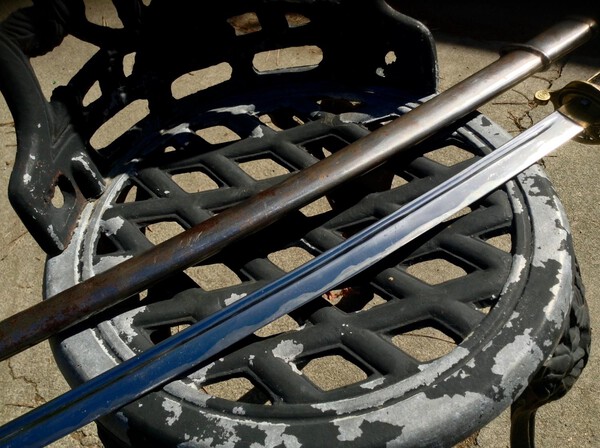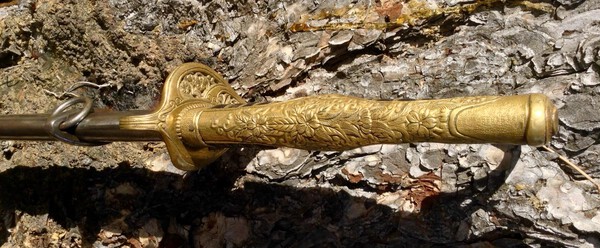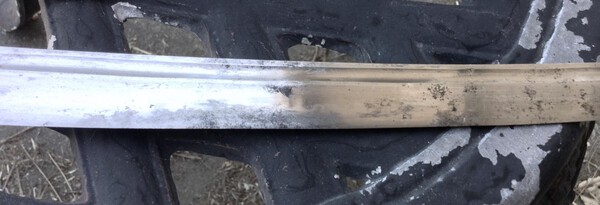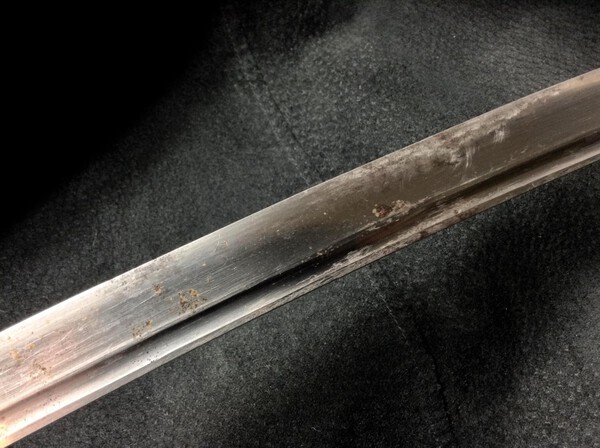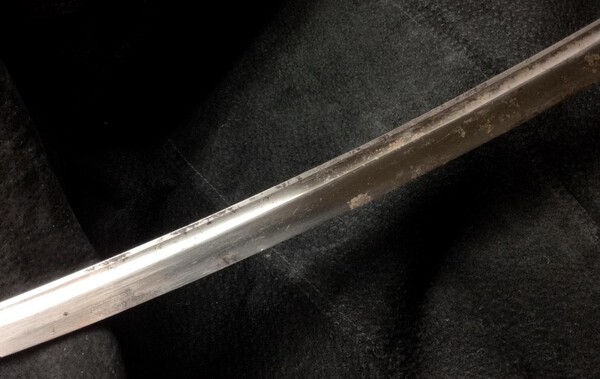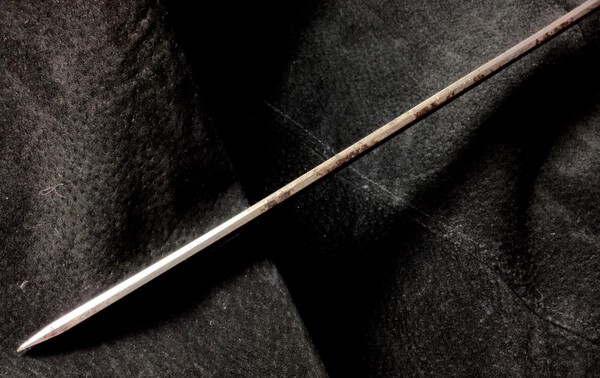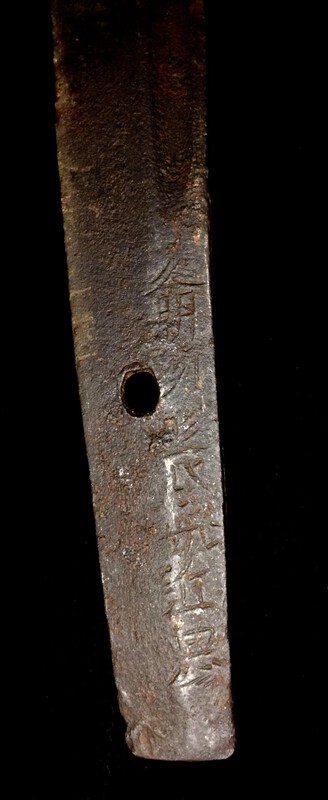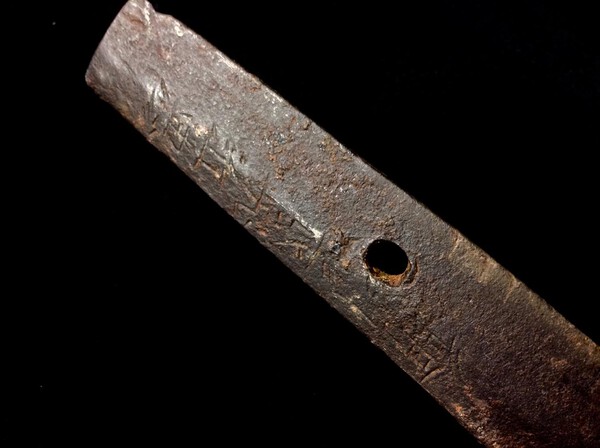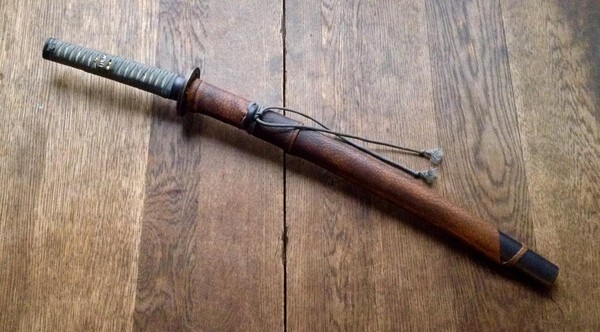-
Posts
28 -
Joined
-
Last visited
Content Type
Profiles
Forums
Events
Store
Downloads
Gallery
Everything posted by Zoom Rabbit
-
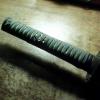
Show Us Your High Class Gunto
Zoom Rabbit replied to lonely panet's topic in Military Swords of Japan
What you can't see in my pictures, because I take great pains to conceal them, are the white cotton handkerchiefs folded up and upon which the steel is actually resting. Nothing shall stain my blades except the blood of my enemy, sir! -

Show Us Your High Class Gunto
Zoom Rabbit replied to lonely panet's topic in Military Swords of Japan
Well, my collection is humble. I have but two guntos: a nice gendai kai gunto by Kuwayama Kanetaka in 1944, and a fine kyu gunto with a blade that strikes me as machine made...but is in the kind of mounts I'm told were designed to take older blades. I'll do a thread about the kyu gunto some day, but here they both are, for now. (Please forgive the modern hangers and sword knot on the kai gunto; I do have an eye out for authentic ones.) I also have an NCO sword. Is that considered a gunto? -
*(Puts on his Indiana Jones hat.)* That sword belongs in a museum! Just kidding. I think the sword belongs in a large enough collection of nihonto that it could be appreciated in its proper context. That rules out me, and anyone else who can't afford the price tag...but if the seller holds firm on that, it should wait long enough for just that buyer to come along. Also, that much damage would bother me. I'd own, but wouldn't feel good about it unless I had a room full of old swords in shira-saya.
-

Strangely Mounted Tanto Mystery
Zoom Rabbit replied to Zoom Rabbit's topic in General Nihonto Related Discussion
I get it now. I shouldn't have posted this topic in this forum. My question wasn't generally nihonto related enough. Sorry for wasting everyone's time. -

Strangely Mounted Tanto Mystery
Zoom Rabbit replied to Zoom Rabbit's topic in General Nihonto Related Discussion
Real Japanese mounts for this blade? Never! I was talking about Chinese mounts for Chinese blade... I am a sword and knife collector, with three (and possibly four) nihonto in my collection. I already discussed one, my wakizashi, in the translation forum. But here's the thing--I collect blades from ALL nations and peoples. Most of my collection is genuine antique in nature, but there are a few of what you would call fakes. I consider them modern commercial swords, and yes, they are mostly Chinese. I do buy damaged pieces if it is something I can repair, which is an enjoyable hobby. I can try my hand at ito-maki, make battle covers and other stuff without damaging something that is authentic Japanese. I will say this. There is no stainless steel or plastic dragon handled sword in my collection. My hopes for this piece were that it had at least been made in the last century, and I appreciate the heads up that the tang was aged artificially. I still don't see what is so contemptible about putting more appropriate mounts on the thing. It's a stout little blade, very sharp. I have a twenty invested in this thing, and if I fix it up I will have something I can sell some day for two twenties. If I do, though, be assured that I would NEVER try to deceive a buyer into thinking it were an authentic Japanese tanto. I believe in karma. -

Strangely Mounted Tanto Mystery
Zoom Rabbit replied to Zoom Rabbit's topic in General Nihonto Related Discussion
Yes, it is true that I am much less knowledgeable than most, if not all, of you guys on this subject. That is why I brought the matter here; while I knew it was of Chinese make, I thought the style of mounting might be a Japanese type I hadn't seen before. I apologize if I wasted anyone's time, but I came earnestly seeking answers. What I don't understand is the negative tone I'm finding. Is this how one treats those less knowledgeable? Is this how one treats a guest? If I were talking to the lot of you in person, I doubt I would get the same hammering. -

Strangely Mounted Tanto Mystery
Zoom Rabbit replied to Zoom Rabbit's topic in General Nihonto Related Discussion
*Sigh* Please take the time to read my post and note that my name is located very notably in my signature. As for the rest...I will waste my time as I see fit. Have a nice day. -

Strangely Mounted Tanto Mystery
Zoom Rabbit replied to Zoom Rabbit's topic in General Nihonto Related Discussion
I've done a lot of google image searching in researching this...and no, there appear to be no other examples of this mounting. I'm going to have to guess that this is unique. Someone probably had a ruined dagger and salvaged the intact pieces to make their own variation. This would explain the larger hole freshly drilled in the tang. The saya and tsuka are both simple leather sleeves, no wood involved in their construction. Apparently, leatherwork was in the maker's bag of tricks, but not woodworking. Being a cheap Chinese blade, there is nothing to be lost in re-mounting it myself. I'll keep an eye out for an appropriately sized tanto with a blade that needs to go, and make a day off project out of it. The tang may be artificially aged, but the presence of rust tells me at least one thing: it isn't stainless steel. I'll give it a second life. If I'm wrong, and this is a standard mounting of some kind..I'd really like to hear about it. I would preserve an ethnographic variation as an example, but if it's someone else's re-mounting, I can do my own work to it. Gonna call this one solved, otherwise. Thanks, guys. -

Strangely Mounted Tanto Mystery
Zoom Rabbit replied to Zoom Rabbit's topic in General Nihonto Related Discussion
If I gave the impression that I thought this might be Japanese, I apologize for the confusion. I'm only familiar with Chinese stuff from this century. Does the rust indicate it might be an antique? I've only seen a rusty tang on twentieth century work (or earlier.) I also wonder about the red leather mounting. Has anyone seen this before? -
Greetings, fellow sword enthusiasts. *(Bows.)* I came across an item at the local antique mall, tagged simply 'short sword.' At first glance it appeared Chinese in nature, too short to be a 'short sword,' I figured it to be a dagger, Chinese mounted in red leather. It was cheap, so I bought it. The blade appears to be a Japanese style tanto blade of ten inches or so in length: Disassembled, it has components in the style of Japanese koshirae...and the tang is shaped correctly. Unsigned. Closeup of the tang. It has some rust, but the end is crudely chiseled. The original mekugi ana was drilled out to accept a larger peg, leaving behind a jagged raised flange around the hole on one side. So, what do I have here? I assume it's Chinese like rice noodles...but the blade seems to have some age. Anyone seen this kind of mounting before?
-

Old wakizashi...? My first mei translation
Zoom Rabbit replied to Zoom Rabbit's topic in Translation Assistance
Late 1500's. Well, it does pre-date the Tokugawa shogunate. Cool factor! Rokujuro: I misspelled Osafune. That is life. This could also be not from Osafune, but it is likely that such a blade was chosen to fake a Kanemitsu...if that is what happened. Also, if this is a Bizento, well... I have inspected the dents on the mune, nicks in the edge and what appear to be blood stains in the steel. One may quibble over what is meant by 'combat,' but I am confident that it experienced misadventure of some kind. Shira-saya? You're absolutely right; the samurai kept their swords in shira-saya unless they were using them for combat. My bad. Thank you for mentioning the need for a professional polish and koshirae from Japan; I had almost forgotten. Meanwhile, I will admire the sword for what it is in the here and now. -

Old wakizashi...? My first mei translation
Zoom Rabbit replied to Zoom Rabbit's topic in Translation Assistance
Got it. I've learned a lot about my sword over the course of this thread, and I thank you guys. My sword was forged (probably) in the village of Ofasune, sometime during the 1400's. If I could go back in time, I would find the village itself quite busy with the production of sword making...like a Solingen, Germany or Toledo, Spain. My sword was made by a smith whose name was later removed when an unscrupulous owner chiseled over it to make it appear that Kanemitsu, one of Masamune's ten disciples, had made the sword a century earlier. The sword was used, fought with...bled upon. And then it was retired to shira-saya, where it stayed until the 20th century when occupying American forces confiscated it, and it was brought to my country. It was pulled out often over the course of several decades, not cared for and allowed to rust...then finally wound up in the pawn shop where I found it. I returned the sword to mounted condition and have been privileged to care for it these last few years. Although it still bears a lot of rust, much more has been removed with uichiko and 'elbow grease.' I keep it oiled, and seek to find better koshirae for it some day. I would like to get it repaired and repolished. The most important thing I've done is: I found out its history as best I could. And my sword is older than Europeans in America! That's pretty cool all on its own. Again, thanks guys, especially to Jean. -

Old wakizashi...? My first mei translation
Zoom Rabbit replied to Zoom Rabbit's topic in Translation Assistance
With the maker unknown, my goal is to determine at least what century it was made. Kanemitsu was working in the 1300's; if this is a Bizento from that time period, I would be happy with that. Any opinions on age or school of make? What is needed is more pics. Of the blade. A shot in daylight which shows off the one good spot of gunome shining through. The edge under fluorescent light. The kissaki. The yokote can be teased out on both sides, but doesn't hold still well for the camera. The bo-hi goes all the way to the (gi)mei on the tang. Another view of the edge. The hamon is visible, but a polish is needed to bring out any detail. The mune. The suspected 'parry marks' are visible. I would like to get the sword sharpened and polished. One can see a few nicks in the edge, and the point is actually missing, which need attention. I'll have to save up for a while first, because the bill for all that would be large... Overall blade length is 20 inches, 23 to the end of the tang. -

Old wakizashi...? My first mei translation
Zoom Rabbit replied to Zoom Rabbit's topic in Translation Assistance
Gimei?!? *(Takes wakizashi outside and trims the blackberries.)* Just kidding. Trying to follow along here; it seems someone altered the mei to attribute it to a famous Bizen smith, Kanemitsu? Well, thumbs down on that scoundrel. Here in 2015, I value the blade for its own sake, and just want to know something of the truth... Many thanks, Jean and Steve. Without you guys, many of us would own 'anonymous old Japanese swords.' -

Old wakizashi...? My first mei translation
Zoom Rabbit replied to Zoom Rabbit's topic in Translation Assistance
Howdy, all. Sorry to bump this topic, but I finally have the better pics that might help finally identify the maker of this sword. Right now, all I know is that someone named Maruko made this sword, and it was pretty there... From a different angle: Any ideas on the damaged area? All I see is chaos, but perhaps someone here can make sense of it. And there is this; I have redone the sword myself in a more traditional Japanese fashion. It now looks like this: I am interested in getting ahold of antique koshirae that I can use, and the proper materials. For example, I'm still tying the handle with parachute cord, although using just the sleeve, because I don't have cotton ito. I would welcome advice. -

Old wakizashi...? My first mei translation
Zoom Rabbit replied to Zoom Rabbit's topic in Translation Assistance
Yeah, the tsuka is way too long, and the more narrow shinogi-ji makes for a blade which is no longer robust, the way a samurai sword should be. Good for cutting tatami only. The whole thing overall is just an inch or so too long for an iai draw for me; I have to hyperextend my shoulder to clear the scabbard, which doesn't make for happy cutting at all. I have two arisaka bayonets in my collection, and they are cool. But listen...you don't have to put one on your rifle to make yourself seem *cough* long enough. You're okay the way you are... Ed: really? I did some research when I bought it that said they had them forged in Japan (unlike the cheaper models, like the practical plus,) but I can't find any word of it online now. I'm glad I paid less than half of retail for it, because I swear I'm looking at damascus steel with an acid-wash hamon and not the clay tempered hamon they advertise. Also, it was hand-forged all right, if that hand was a machine. :| As long as we're stuck on the subject of improving my koshirae, how about a recommendation for what would be an economical source for fittings of the quality you suggest? I don't have to have gold sakura and stuff imported from Japan, do I? -

Old wakizashi...? My first mei translation
Zoom Rabbit replied to Zoom Rabbit's topic in Translation Assistance
It's a Paul Chen orchid katana. *(Tosses it over his shoulder.)* Junk, I know, but a fine example of what modern Japanese koshirae look like. I'm assuming that custom made fittings like what we're talking about would be a degree higher in quality. Gunto, I like your style. I was using my 9mm parabellum, commercial model with four-digit serial number. I've neen pouring over the kanji tables myself, but it's obvious to me that with the unclear signature I have, I could spend a years trying to match up my squiggles. It looked as if Moriyama-san and Toryu-san had an idea what they might be...but my computer won't display Kanji. :| Can't install them because I can't find the flipping windows XP disc... Could some helpful human help this foolish rabbit out by telling him what those guys came up with in Romanji? I'm probably still stuck, but it will give me an idea where to start. -

Old wakizashi...? My first mei translation
Zoom Rabbit replied to Zoom Rabbit's topic in Translation Assistance
*(Sigh)* Please understand then that I am an art appreciator who cannot afford to send his Van Gogh overseas for a proper frame. It's wal-mart or thumb tacks on the wall for me. (Note: I absolutely must have this sword mounted for iai practice...and shira-saya is balanced completely wrong for this. As a metaphor, one must consider that the art is also a weapon in this case--the best of its kind forged by man.) However, I didn't actually post this topic to seek approval for my cheap and ugly chinese koshirae. I wish to establish who forged this and when, for the purpose of common human knowledge. It's clearly old; we all, art snobs and pop art collectors alike, have a shared interest in cataloging what is in the world. Thus... I took my original photo of the mei and printed it out. Then I took the actual tang and compared what I could make out in person to what is in the photo. What is noted in marker is what I am sure is struck there by the smith as his mei. There could be more, but I cannot pull the detail from the background noise of rusty bumps and wiggles. Forgive my shouting, but I think I need to emphasize this: THE MARKS ARE ON THE PHOTOCOPY, NOT THE TANG ITSELF!!! This time I split the signature in three sections, which overlap. The top, where the blade begins: The middle: The end of the tang. And yes, that is absolutely the last character. I see no evidence of more below that. I noted two places of interest, A and B. A is a rough patch in the steel where I suspect a lot of detail has been lost. That's the smith's name, isn't it? Crap stick. Area B is a spot where the part of the kanji that curves off to the right disappears altogether, then comes back further up. Looking at it, it seemed apparent to me that some of the steel has been removed at some point in its history. I do have one bit to say about the quality of Japanese koshirae versus chinese. I do have a modern Japanese commercial sword (i'm sure you will all recognize it) with furniture of very fine quality. Perhaps not up to your standards, but proof that I'm not a complete philistine... It's too long for me to use in an iai draw, but it's cool anyway. I'll tell you guys this: if I can ever afford to, I'll have my sword properly fitted. In Japan. *(Shoots Gunto)* :D Just kidding. But you had to see that coming... -

Old wakizashi...? My first mei translation
Zoom Rabbit replied to Zoom Rabbit's topic in Translation Assistance
*(Cuts off Gunto's head.)* *(Bows to the rest of the forum.)* I really must apologize for my outburst, but it was my right. While honest disagreement with my choice is understandable, rudeness is not. My sword, as ugly as it is, is due an apology. He must have missed the part where I said I could not afford better fittings.* Grey Doffin, rice glue you say? I would think that leaving the shira-saya as I collected it would be the correct answer. If that's a legal fix, I will consider it. Not sure if I'm going to switch the blade from one mounting to the next every day...but in another twenty years or so, when I retire from kenjutsu altogether, I will replace it to its storage mountings. Yes, the shira-saya is beautiful. That's why it has its own place on the sword stand. *I did not use cheap chinese fittings. The sword blade I removed was hand-forged from high-carbon steel, affordable but not wall-hanger quality. -

Old wakizashi...? My first mei translation
Zoom Rabbit replied to Zoom Rabbit's topic in Translation Assistance
No, Toryu-san! I would never use my wakizashi for yard work. Just appreciation, meditation and iai draws onlyin the privacy of a temperature-regulated home. For yard work I have (yes, groan) chinese stuff that I can use on the bamboo some previous tenant planted in my back yard. Also shinai for use in sparring and bokken for use on the pell. The ONLY thing I would ever allow to touch my blade (pictured here) would be an enemy foolish enough to attack me while I'm holding a sword...and then I would perform chiburi, wipe clean before replacing to the scabbard, and as soon as possible I would clean with uichiko powder and re-oil with proper choji. You rock! Heck, that looks clearer than the real thing almost. Guys, I will consider your advice about replacing the sword to its shira-saya. I know you mean well. It's just...well, nothing compares to the balance and feel of this sword in a draw. The chi (*ki* for us nihojin types) is like lightning and water. In the shira-saya it was in cold sleep--an artifact more than a living sword. Note: the old shira-saya is also in poor condition, and split to the point that it cannot be drawn at speed or used in a cut if necessary. I could repair with glue, but I know for sure that that is a no-no of great order. The shira-saya is carefully preserved. I'm going out today to get a better camera. Better photos soon, I hope. -

Old wakizashi...? My first mei translation
Zoom Rabbit replied to Zoom Rabbit's topic in Translation Assistance
Actually, guys, I did use my name. It's in my signature (I assume that counts.) I am Jim Coomber, and I'm pleased to meet you all. Benatthelake, while I respect your point of view on this matter, I would invite you to also consider mine. I am a lifelong swordsman (41 years yard work) whose aspiration was to have actual samurai equipment for my own use. The more I studied the traditions of bushido growing up, the more I learned to appreciate the presence of these antique works of art in our society. When I found the wakizashi, my first thought was that I could bring this old warrior into the twenty-first century. When I said I was lucky enough to use this as my own iaijitsu sword, I sincerely meant it. Priveleged, even. When re-mounting this sword, I was VERY careful to adapt the fittings TO the tang. No possibly nihonto blades were harmed in the creation of this weapon. Also...this sword is in very poor polish; I would also not use a blade in very good condition for a purpose such as this. My gendai kai-gunto, for example, is in the condition in which I found it: untouched. As for the quality of the fittings...hey, I'm poor. I'm a cook who can't afford to send it to Japan for professional furniture. Actually, one should respect the fact that I painted the scabbard and tied the handle myself. There is a large measure of myself that has gone into my wakizashi, and I would think less of myself for having paid another to do it. Unless you just have a problem with China. :D Not me; they made the fittings for my sword! I love China. Back on topic. I do have better close-ups of the mei, but I was keeping myself within the five picture limit. Having read the forum rules. :| Here is the top half: The bottom half. I really am sorry for the quality of these photos. My phone is so, so cheap. And here is a happy note. From one samurai cook in Oregon... -
This is my first time getting a mei translated. Let me thank you in advance for the time you spend helping newbies like me... The subject is a wakizashi in really poor polish, and what I think to be parry marks on the back of the blade. I bought it in shira-saya mountings from a dealer I trust for $450. I bought a modern chinese wakizashi, took it apart and discarded the blade, then adapted the fittings to my new (old) blade. I tied the handle myself with parachute cord--which does work, although you have to pull it very tight in the process. Here is a photo of my sword along with the now-empty shira-saya mountings. Here is the mei in question. I apologize for not photographing it top to bottom; I wanted to get more detail in by going sideways. I also apologize for my cheap, cheap phone camera quality. If you can actually read this, I salute you. The blade was quite rusty when I bought it. I cleaned it up the best I could with uichiko powder and stopped the rust with choji oil. I can see elegant patches of choji-ba with good utsuri in the hamon, although my camera doesn't have a chance of capturing an example. Here is a photo of one larger choji-ba right about where the reflection of my head is... The kissaki. One can find the yokote, but the really lousy polish makes it invisble, I think, in my best photo. It's very faint, but appropriate and present on both sides. One might be able to make out the boshi; note the bite out of the very tip. Gah. The parry marks I mentioned. I realize they could be faked, but my gut tells me this blade was actually fought with. Again, thanks for your help with this. The photo I use as my avatar is the handle of this sword...I get to use it every day when I practice iai draws. :D



